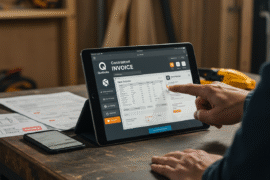This article may contain references to products or services from one or more of our advertisers or partners. We may receive compensation when you click on links to those products or services. Nonetheless, our opinions are our own.
The information presented in this article is accurate to the best of our knowledge at the time of publication. However, information is subject to change, and no guarantees are made about the continued accuracy or completeness of this content after its publication date.
- What is the Child Tax Credit?
- Tax Credit Basics for Families
- How the Credit Works
- How Much You Can Receive
- Credit Phases and Income Limits
- Who Can Claim the Credit?
- Qualifying Child Criteria
- Social Security and Citizenship Rules
- How to See If You Qualify
- Mistakes to Avoid When Checking Eligibility
- Steps to Claim the Child Tax Credit
- Final Thoughts on Eligibility for Child Tax Credit
- Frequently Asked Questions
- Recommended Reads
What is the Child Tax Credit?
The Child Tax Credit helps families lower the amount they owe on their taxes for kids who qualify. This gives a lot of money help for families at tax time.
To be able to get this credit, you must meet some rules, like age, how the child is related to you, where you live, and how much money your family makes. A child who counts for this credit must meet rules to be your dependent and stay with you for over half of the year.
The size of the credit can get smaller if your adjusted gross income goes up. Some credits, like the Additional Child Tax Credit, let families get up to $1,700 back as a refund, even if they do not owe any tax.
Tax Credit Basics for Families
Getting through tax season can feel tough, but the Child Tax Credit can help many families. If you meet the rules, you can pay less in taxes for a child who qualifies. This tax credit can help you save a lot of money. You need to know the rules, like how old your child needs to be, where you all need to live, and how much money your family earns. This will show you the way to get the credit, so you can make sure you follow the right steps to claim what is yours.
How the Credit Works
The Child Tax Credit helps families by giving them money back on their taxes when they have children who qualify. If you are getting ready to do your taxes or looking at things like the Additional Child Tax Credit, knowing how this works can really help you. This credit helps with the cost of taking care of a child.
How Much You Can Receive
The Child Tax Credit is a tax help program from the IRS. It helps families who have children who fit the rules for the credit. This program brings down the total tax you have to pay. A family can get up to $2,000 for each child. The amount can change based on the child’s age and the family’s income. The normal credit is not refunded to you. This means it does not go over your tax bill, and it stops when you do not owe anything. But some families can get the Additional Child Tax Credit. This part lets you get back up to $1,700 in refunds.
This policy helps families who have money problems. It can be used by parents for their own kids, kids they have adopted, or kids they take care of. When you know the details, you can make better plans for the current tax year.
Credit Phases and Income Limits
The Child Tax Credit can help you pay less in taxes if you have children who qualify. If you meet the rules, you can lower what you owe, and sometimes you might even get money back as a tax refund.
Your adjusted gross income, or AGI, changes how much credit you can get. For example, if you file as a single person, phaseouts start when your AGI is $200,000. If you file together with your spouse, it starts at $400,000. Parts of the credit, such as the Additional Child Tax Credit, can give families help with money even if they do not owe taxes. It is important to follow the steps the right way so you get the full credit and do not make mistakes.
Voted "Best Overall Budgeting App" by Forbes and WSJ
Monarch Money helps you budget, track spending, set goals, and plan your financial future—all in one app.
Get 50% OFF your first year with code MONARCHVIP
Who Can Claim the Credit?
Not all parents can get the Child Tax Credit. To get this credit, a child must fit rules about age, where the child lives, their relationship to you, and if they depend on you. Your income is also important when you apply. You might not get the full credit if you make more money. If your income is over a certain amount, you may still get some credit, just not the full one.
General Requirements
To get the Child Tax Credit, you need to meet these rules:
- Age test: The child must be 16 years old or younger by the end of the tax year.
- Relationship test: The child must be your own child by birth or adoption or your brother, sister, niece, nephew, or grandchild.
- Residency test: The child must have lived with you for more than half the tax year.
- Income test: Credits start to go down once your income is $200,000 if you file alone or $400,000 if you file together with your partner.
Your dependent status also needs to be checked by the rules set by the IRS. If you meet these rules, you can get many good tax benefits.
Divorced or Separated Parents
It can be harder to figure out who gets the credit if the parents are divorced. If both the parents try to claim the same child, only one can get it. Most of the time, the parent the child lives with for most of the year can claim the credit. But the other parent can also get the credit if there is something in writing that says so, and they use IRS Form 8332 for it.
It’s important to make sure that your filing is clear. This helps you avoid delays or audits. When you know about these exceptions, it can make the process much easier.
Qualifying Child Criteria
To get the Child Tax Credit, the child must meet some rules. The rules are about age, where the child lives, and the child’s relationship to you. A child can be your biological child, adopted child, or foster child. A niece, nephew, or grandchild may also get it if the right rules are met.
Who Qualifies as a Child for Tax Purposes
To get in, children have to meet the things listed below:
- Age: The person must be 16 years old or younger by the end of the tax year.
- Relationship: This covers biological children, adopted children, foster children, siblings, nieces, or nephews.
- Residency: The person must have lived with you for more than half of the tax year. There are some exceptions for special cases, like when they go to school or if they are away for medical reasons.
You need to have a Social Security Number for this. Also, you must be a citizen or have the right status. This is important for people who want to use the service or get the benefit. If you do not have these, you cannot get help from this program. Always check that you meet both of these before you go forward.
You need a real social security number (SSN) to claim the Child Tax Credit. The child must be a U.S. citizen, national, or resident. If you have adopted a child in the right way, they count as a U.S. citizen. You cannot use an ITIN or any other number like that. Only a real SSN is okay for this.
If you do not meet these requirements, you will be disqualified. So, make sure you have the right documents with you.
How to See If You Qualify
To see if you can get the Child Tax Credit, look at the main rules, like how old your child is, where you and your child live, and how much money you make. This is a simple process. There are tools like IRS checklists that help you go through each needed step.
Documents You Need to Check Eligibility
Get the following papers ready to check if you can take part:
- Tax forms like IRS Form 1040 and Schedule 8812.
- All details about your money to show your income and what you are allowed to take off.
- Checked details about who your child is and that they depend on you.
- An SSN that works for any dependents you want to claim.
- A simple paper or other proof to show that you lived with your child for more than half of the year.
Having these papers with you makes the filing process go smoothly.
Mistakes to Avoid When Checking Eligibility
When you look at if someone is eligible, there are some mistakes people often make. A lot of people do not read all the rules. Some do not give the right papers or miss giving new details. A few people think they qualify but do not check all the points. There are some who forget to ask or look for help if they feel lost. Many just guess what is right, and this causes more issues. To make things easy, read all rules carefully. Always give all your papers, check every point, and ask for help if you do not know what to do. This way, you can avoid most problems.
Make sure you do not make these common mistakes. This will help you get all the credit you should get.
- Getting the rules for who can apply wrong.
- Leaving out important details, like how much money you make.
- Filling out forms with missing or wrong info.
- Hurrying and not checking everything before you send it in.
Check your info with IRS tools to make sure you do not have mistakes.
Steps to Claim the Child Tax Credit
Follow these steps to claim the Child Tax Credit:
Step 1: Get all the documents you need ready. This includes things like your W-2 forms and Social Security numbers for your dependents.
Step 2: Complete IRS Form 1040 and Schedule 8812.
Step 3: Check the dependent details, like their SSN and where they live.
Step 4: Send your tax return online or by mail. Direct deposit will get your money to you faster.
Final Thoughts on Eligibility for Child Tax Credit
It is important to know the rules to be able to get the Child Tax Credit. This can help you get the most out of your taxes. When you read up on who can get the credit and get all the right papers ready, you will feel more sure about claiming it. Keep up with the newest news and rules to make sure you get the full value of this credit.
Frequently Asked Questions
What happens if my income is too high to qualify for the full credit?
If your income is too high, you may not get the Child Tax Credit, or you might only get part of it. The IRS has set limits for this credit. If your income goes over these limits, the amount you get will go down or stop. It is a good idea to check the current rules each year, because they can change. This can help you know if you are able to claim the credit for your child or not.
Do high-income earners lose the credit entirely?
No, the credit does not last for people who make more money. If you file single, the reduction begins when your income gets to $200,000. For joint filers, it starts at $400,000. But, you can still get a part of the credit in some cases.
What if more than one person claims the same child?
If more than one person says the same child is theirs, the IRS has rules to decide who can claim the child. You, or they, may have to give proof. A parent usually gets to claim the child over someone who is not a parent. If both are parents, the one the child lives with the most often will be able to claim the child. If it is the same amount of time, the parent who has the higher income can claim the child. If this happens, be ready to show any needed papers to the IRS to back up your claim.
Can both divorced parents claim the credit?
The IRS gives the tax credit to the parent who takes care of the child most of the time. The other parent can get the credit only if both parents have a written agreement, like IRS Form 8332.
Is the Child Tax Credit refundable?
Yes, with the Additional Child Tax Credit, families have a way to get up to $1,700 back, even when they do not owe any taxes.

Reviewed and edited by Albert Fang.
See a typo or want to suggest an edit/revision to the content? Use the contact us form to provide feedback.
At FangWallet, we value editorial integrity and open collaboration in curating quality content for readers to enjoy. Much appreciated for the assist.
Did you like our article and find it insightful? We encourage sharing the article link with family and friends to benefit as well - better yet, sharing on social media. Thank you for the support! 🍉
Article Title: Eligibility for Child Tax Credit: Who Can Qualify?
https://fangwallet.com/2025/07/09/eligibility-for-child-tax-credit-who-can-qualify/The FangWallet Promise
FangWallet is an editorially independent resource - founded on breaking down challenging financial concepts for anyone to understand since 2014. While we adhere to editorial integrity, note that this post may contain references to products from our partners.
The FangWallet promise is always to have your best interest in mind and be transparent and honest about the financial picture.
Become an Insider

Subscribe to get a free daily budget planner printable to help get your money on track!
Make passive money the right way. No spam.
Editorial Disclaimer: The editorial content on this page is not provided by any of the companies mentioned. The opinions expressed here are the author's alone.
The content of this website is for informational purposes only and does not represent investment advice, or an offer or solicitation to buy or sell any security, investment, or product. Investors are encouraged to do their own due diligence, and, if necessary, consult professional advising before making any investment decisions. Investing involves a high degree of risk, and financial losses may occur including the potential loss of principal.
Source Citation References:
+ Inspo
Internal Revenue Service. (2025, January). Child Tax Credit. U.S. Department of the Treasury. Retrieved from IRS official website https://www.irs.gov/credits-deductions/individuals/child-tax-credit Internal Revenue Service. (2024, March). Refundable tax credits: Additional Child Tax Credit. U.S. Department of the Treasury. Retrieved from IRS official website https://www.irs.gov/credits-deductions/individuals/refundable-tax-credits












































